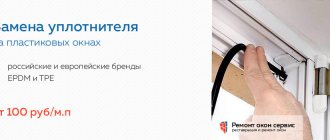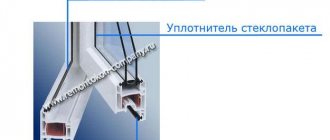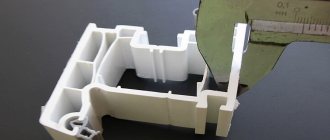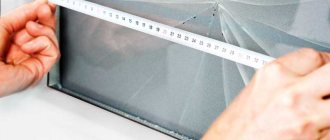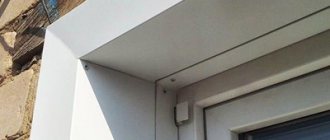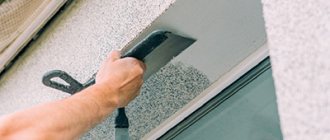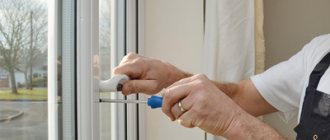Hi all!
The permanent host of the blog for Rukozhopov, Alexander Alexandrov, is in touch with you as always.
In my last article, I told you the heartbreaking story of my friend, and to be precise, about his plastic balcony door, which practically “died”. Based on her example, the main types of faults in plastic doors and methods for solving them were compiled.
So, one of the defects of plastic doors is the loss of the working properties of the sealing gum. Of course, it was possible to describe the entire replacement process in that article, but I decided to write a separate post on this topic in order to sort everything out. I read it once, got the hang of it, went and changed it, and there’s no point in paying money for something you can do yourself. So, my ass-handed little hands, especially for those who are too lazy to read the article, like it, subscribe to the news - I divided the article into sections:
When is it time to change the seal of plastic doors or windows?
Friends, in order to understand that the rubber seals of your windows or doors have ceased to fulfill their noise and heat insulation function, it is quite simple. The main prerequisites for replacing them are:
- Draft. Because if the windows “siphon”, then you can’t live without it...
- Visually assess the condition of the seal - cracking, dryness and all sorts of defects - this is also a reason for replacement.
- Do you go sledding in winter from an improvised skating rink leading from a plastic window into the room? For children this is of course a great joy, but most likely this is a depressurization of the double-glazed window :)
- Do you start to imagine the music of Scottish bagpipes? - most likely this is a glitch or a migraine attack :) In fact, this is a loss of sound insulation and another reason to change the plastic window seal
- Well, if every day you remove a bountiful harvest of spore-like fungi and noble blue mold from your window, then this is also a reason to think about replacing the sealing rubber bands...
If you have become the “lucky” owner of at least one of the above items, then soon you will have a very exciting trip to the store to purchase a new rubber seal for a plastic window.
How to care for and how to replace?
Over time, the seal wears out; its exact service life depends on how often the door is used. Under intense load, it will have to be changed after 5 years. If the door is used infrequently and does not experience strong climatic influences, then the seal will last up to 20 years.
It must be replaced in the following cases:
- a draft appears, it blows from under the door;
- Condensation accumulates on the glass unit in the door and ice forms;
- the tape peeled off, began to crack, and began to ripple;
- The sound insulation of the house has become worse;
- Due to the accumulation of moisture, mold appears on the door.
Main types of sealant. Manufacturer overview
Gone are the days when metal-plastic windows or doors were available only to those who clearly “can’t eat the last dick without salt.”
Today, purchasing components for plastic doors or windows is not a problem. You can buy sealants for plastic windows not only in specialized companies, but also in large construction stores, such as: Leroy, HDM, OBI, etc., etc. For example: here in Rostov, in Leroy, the cost of a rubber seal is about 370 rubles (manufacturer VEKA).
This suggests that if you have plastic windows or doors from well-known manufacturers, then it will not be difficult to find components for them. In order to help you make an informed choice and not get “hands-on”, let’s look at the main types of rubber seals, and some very valuable and useful tips from your humble servant.
Design Features
All plastic doors and windows consist of:
- The window frame, which is the basis of the entire product. The door leaf and fittings are attached to it.
- The door leaf is an opening and closing element.
- Fittings that enable control and fixation of the moving part.
- A double-glazed window is a glass part hermetically installed in a profile, consisting of 2 or more elements with special separators between them.
How to choose a seal according to the manufacturer's brand?
As I already said, now almost everyone can buy metal plastic, and as you know, demand creates supply. The thing is that each manufacturer has its own seals and therefore we will look at the most popular types of sealing rubber bands by manufacturer brand.
REHAU double-leaf seal
It is also used for profiles from MONTBLANC, PROPLEX, BRUSBOX.
Sealant for plastic windows VEKA
Sealant KBE
KBE seal modified with an additional stiffener (KBE 228)
These are the main types of rubber seals for plastic windows. If none of the bottoms suits you, then we take a sample and go in search.
Many will say that seals are sold only to companies and only in coils of 100 meters. “Izdezh!” - no one has canceled retail sales - you just need to look. The only thing I can advise you is to correctly measure the linear length and take plus 15 cm for trimming.
When choosing a seal for plastic windows, in addition to the manufacturer, you must also take into account that the rubber bands themselves differ in composition.
Self-repair of double-glazed windows
Replacing a damaged glass unit with a new one takes 10-15 minutes, but replacing one of the glass units will take significantly more time and effort. You should know that “branded” double-glazed windows with energy-saving glass, gas injection and other useful options cannot be restored. A double-glazed window manufactured at home is of the same quality as mass-produced inexpensive products. But if one was installed, you can safely carry out the repairs yourself.
It is not recommended to remove glass fragments in the frame - the probability of bending the spacer (distance frame) or cutting yourself is quite high. Only parts that threaten to fall out are removed. Using a knife, wide screwdriver or spatula, remove the glazing beads holding the bag. The blade is driven between the bead and the frame, uniformly widening the gap along the entire length until the lock disengages. It is recommended to start with the side elements. Having freed the glass from the beads, remove the spacer inserts that are pushing it apart, remembering their location. The damaged glass unit is removed from the frame and placed with the broken glass up on the table.
In the photo - removing glazing beads using a knife
The outer, hardened layer of sealant (polymer or silicone) on the end surfaces of the bag is cut through with a thin sharp knife to the spacer frame. The fragments are quite easily separated from the inner adhesive layer (butyl sealant). Large areas are separated by inserting a knife between the glass and the spacer. Part of the butyl layer and outer sealant are removed from the plane of the spacer frame freed from glass. The cut is made along the bevel of the outer corner of the spacer, covering approximately a third of the width of its plane.
Types of rubber seals for plastic windows
Rubber or caoutchouc seal
The most common and the best in my opinion. Characterized by increased wear resistance to heat and cold.
Polymer seal
This seal is made on the basis of PVC, that is, practically from the same material as the plastic itself. The main disadvantages are that they are quite quickly destroyed by UV rays and are quite sensitive to temperature changes.
Polyethylene filling with foam filling
I haven’t personally seen it myself, but in my opinion it’s only suitable for sealing old wooden frames!
So, we’ve chosen a suitable seal according to all parameters and we’re starting to get hands-on!
What materials are door seals made from?
The thermal insulation and sound insulation properties of the seal largely depend on the type of material from which it is made. Most often, three types of raw materials are used for these purposes. The classification in this case looks like this:
- Rubber door seal . The model is intended for use in outdoor conditions. The material used is rubber. It is optimally suited for the manufacture of seals installed on street doors, since the rubber product retains its original technical characteristics for quite a long time even in the most severe weather conditions.
- Silicone door seal . It is difficult for silicone to compete with rubber in terms of performance properties. Silicone models cannot be saved even by special additives mixed by the manufacturer into the raw materials to improve the technical characteristics of the finished product. Attempts by manufacturers to make them more durable have not been successful. However, the products are excellent for installation on interior door structures, where they serve well and for a long time.
- Foam door seal . The model belongs to budget options that quickly lose their consumer properties. It happens that such a seal cannot withstand even 2 months of intensive use. Temperature changes, high humidity, and pollution have a destructive effect on the material. As a result, the foam rubber crumbles and breaks down into small particles over time. At home, with less aggressive external factors, the material becomes denser and decreases in volume over time, which also negatively affects its ability to retain heat, odors and sounds in one room.
- Fleecy (brush) tape . The seal is designed for installation on sliding doors. Its main task is to protect the interior of a room or cabinet from dust. This model acts as a sealant rather than providing thermal or sound insulation.
Rubber compressor
Silicone option
From foam rubber
Brush tape
Replacing a plastic window seal with your own hands
In order to carry out all this correctly, we will need additional “gadgets”:
- Silicone glue gun
- Silicone glue
- A knife, a knife or scissors :)
1. So, first of all, remove the old rubber seal. The sealing rubber has a joint, finding which we pry up the rubber and pull it out of the groove (usually this happens without difficulty)
2. We wipe the grooves to the usual “Mr. Muscle” state, because the dirt will not allow the new seal to “settle” normally!
3. Apply a little glue to the corners of the window so that the elastic sits in place and does not “walk”, and then insert the seal, starting from the old attachment point.
4. You just need to insert the rubber seal without allowing sagging or tension.
5. The joint of the seal is “cut” tightly and glued with glue.
As you can see, there is nothing complicated - the only thing that needs to be taken into account is that under no circumstances should the sealing rubber be allowed to rupture, otherwise the whole point of replacing it will be lost.
Prevention
We tell you how to prevent your balcony door from breaking.
- Do not buy double-glazed windows from unknown semi-legal manufacturers. The design has many parts that bear the load. Plastic balcony blocks from reliable companies always last longer because they use high-quality fittings.
- Do not use physical force when opening/closing the door. Any difficulties should be corrected immediately by adjustment or repair.
- Do not install double-glazed windows on single-chamber doors. This gives a large load for which the structure is not designed. All mechanisms will quickly fail.
- If you are not confident in your own abilities, call a window technician.
Reasons for failure of PVC structures
Plastic products fail for a number of known reasons. If you understand the source of the malfunction, eliminating the problem is not difficult.
Main causes of breakdowns:
- Installation companies make mistakes during installation - they do not maintain the level, the sealing is done poorly. Such actions lead to moisture accumulation, friction, and hardware breakdowns.
- The use of defective products (poor quality of sealant, gaskets, reinforcing elements) leads to sagging, fogging of the glass, and deflection of the frame.
- If the product is used incorrectly or not taken care of, moving parts fail and the sealing of the structure is compromised.
A breakdown can be fixed if you know its cause, but each individual case requires certain skills, as well as the availability of a special tool.
